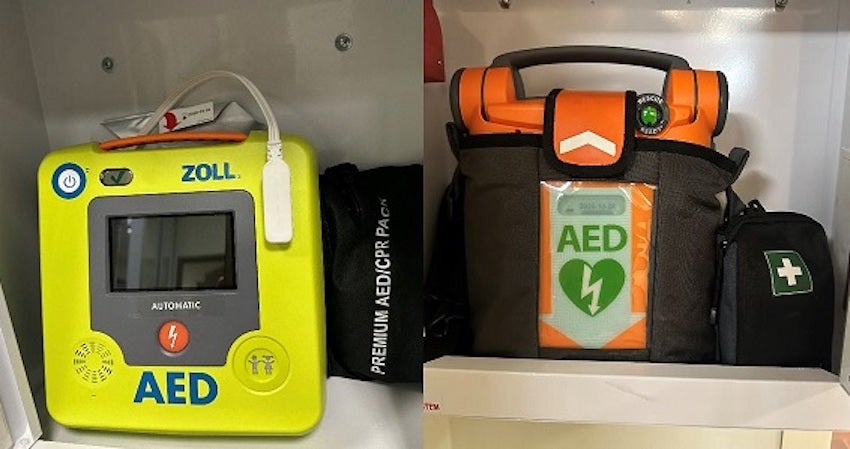
If a cardiac emergency occurred in your workplace, would you know what to do? Timing is critical, and delays can have consequences.
As is the case with any emergency or medical event, always first call 911 or, if on the University of Pittsburgh's Oakland campus, (412) 624-2121. Once first responders are on the way, you can do even more to help save a life -- find the Automated External Defibrillator.
There are approximately 215 AEDs distributed throughout the Oakland campus locations, with some buildings having multiple AEDs. Each Regional campus has AEDs and similar procedures are utilized throughout. Greensburg has 16 AEDs, Bradford has 15, Johnstown has 15, and Titusville has 10.
_______________________
Know where to find your nearest AED with these campus maps:
Staff and faculty at all of Pitt’s campuses are encouraged to know where to find the nearest AED and how to use it. AED’s are devices that analyze the heart’s rhythm and can deliver a shock — either automatically or manually — to help resuscitate a patient.
CPR/AED training is available and is dependent on the campus, with classes being led by campus police, third-party organizations such as the Red Cross or American Health Association. Please review the training avenues available on the Safety Website.
In 2015, the Institute of Medicine, in a report titled “Strategies to Improve Cardiac Arrest Survival: A Time to Act,” said cardiac arrest — by even conservative estimates — is the third leading cause of death in the U.S. behind cancer and heart disease. It said there are approximately 395,000 cases of cardiac arrest that occur each year outside of a hospital setting in the U.S., with less than a 6 percent survival rate. The survival rate increases to 24 percent when the cardiac arrest occurs inside a hospital – there are about 200,000 such cases each year in the U.S.
“Following a cardiac arrest, each minute without treatment decreases the likelihood of survival with good neurologic and functional outcomes,” according to the report. “Thus, the consequences of delayed action can have profound and, in many cases, avoidable ramifications for individuals, families, and communities.”
In addition to campus buildings, the majority of the Pitt Police Department's patrol vehicles are equipped with an AED and all University Police Officers are trained in CPR and the use of AEDs. In the event of an emergency, please first contact police at your campus:
Bradford: (814) 368-3211 from any non-campus phone, 10333 from any campus phone
Greensburg: (724) 836-9865
Johnstown: (814) 269-7005
Oakland: (412) 624-2121 or 4-2121 on campus
Titusville: (814) 827-4488
About the AEDs
Fully automated defibrillators and semi-automated defibrillators analyze the heart's rhythm. Fully automated AED deliver a shock if commanded by the device software without the intervention of the person — required by semi-automated AEDs — using the device.
During the CPR/AED training with members of your unit or department, identification of the AED type should be a topic of discussion.
Watch the step-by-step video for the ZOLL Powerheart G5 (primarily orange).
Watch the step-by-step for the ZOLL 3 AED (primarily green).
Watch the video for the ZOLL Powerheart G3 (primarily blue and yellow).
Using the AED
Generally, here's what to do to use the defibrillator:
- Find the cabinet containing the AED, then call the appropriate University Police Department and/or 911.
- Open it and remove the AED. An alarm should ring indicating the AED has been accessed in the cabinet.
- Remove the AED from the case.
- Open the lid, this will start the AED voice prompts to assist the user with additional instructions.
- Follow the instructions provided by the AED.
- There is a “Ready Kit” associated with each AED. Typically these are found affixed to the carrying case.
- The kit includes scissors to remove clothing and a shaving razor to remove body hair (if needed).
- Once the area is clear, place the electrodes as directed by the AED.
- Continue to follow the instructions provided by the AED, including CPR, until emergency responders arrive.
- Provide a recount of your actions to the emergency responders.
How to Get an AED
University-affiliated schools or departments interested in obtaining an AED should contact the Department of Environmental Health and Safety by emailing safety@pitt.edu for assistance.
All departments or units must purchase their own AED with the assistance of the Environmental Health and Safety Department. EH&S strongly encourages AEDs manufactured by Cardiac Science — if the AED manufacturer is ZOLL, EH&S will perform an annual integrity check and necessary maintenance. The cost of purchasing and installing an AED and its cabinet is roughly $2,250.
For equipment other than ZOLL, all testing and maintenance is the responsibility of the department or school providing the AED. All AEDs at the University of Pittsburgh must be registered with EH&S, so inventory can be maintained, and regulatory compliance and training requirements can be assured.
Additional guidance and guidelines can be found listed on the Environmental Health & Safety's website, under Safety Manual.